Shaping Future Urbanization: A Systematic Review of Predictive and Preventive LUC Indicators for Sustainable New City Development
Abstract
1. Introduction
2. Theoretical Foundation
3. Materials and Methods
3.1. Systematic Literature Review
3.2. Bibliometric Analysis
4. Results and Analysis
4.1. References Profile Analysis
4.2. Review Results
4.2.1. Primary Concept of Predictive Indicators
4.2.2. Physical Geography Category
4.2.3. Climate Environment Category
4.2.4. Socioeconomic Category
4.2.5. Urban Attraction Category
4.2.6. Policy and Regulation Category
4.3. Future Urbanization Challenges as Preventive Indicators
5. Synthesis and Discussion
5.1. Conceptual Framework of Interconnected Indicators for Future Urbanization in NCD
5.1.1. Internal Predictive Structure in City Scale
5.1.2. Regional Preventive Structure in Agglomeration Framework
5.2. Limitations and Future Research
6. Conclusions
Supplementary Materials
Author Contributions
Funding
Institutional Review Board Statement
Informed Consent Statement
Data Availability Statement
Acknowledgments
Conflicts of Interest
Abbreviations
| LUC | Land use change |
| NCD | New development city |
| SLM | Sustainable land management |
| SLR | Systematic literature review |
| PICOC | Population, intervention, comparison, outcome, and context criteria |
| PRISMA | Preferred reporting items for systematic reviews and meta-analyses |
| GDP | Gross domestic product |
| SEZ | Special economic zone |
| NTL | Nighttime lights |
| ERQ | Ecological resistance quality |
| LUCP | Land use conflict potential |
| UDLS | Urban development land use suitability |
| UCD | Urban compactness |
| TDA | Tourism development assessment |
| SDH | Spatial development heterogeneity |
| UGI | Urban gravitational interaction |
References
- Thompson, T.Y.; Lockhart, K.; Siame, G. Introducing the New Cities Map; London, UK; August 2023. Available online: https://www.theigc.org/publications/introducing-new-cities-map (accessed on 18 July 2025).
- Moser, S.; Côté-Roy, L. New cities: Power, profit, and prestige. Geogr. Compass 2020, 15, e12549. [Google Scholar] [CrossRef]
- Su, X. Building new cities in the Global South: Neoliberal planning and its adverse consequences. Urban Gov. 2022, 3, 67–75. [Google Scholar] [CrossRef]
- Moser, S. New Cities: Engineering Social Exclusions. One Earth 2020, 2, 125–127. [Google Scholar] [CrossRef]
- Watson, V. African urban fantasies: Dreams or nightmares? Environ. Urban. 2013, 26, 215–231. [Google Scholar] [CrossRef]
- Moser, S.; Avni, N. Analysing a private city being built from scratch through a social and environmental justice framework: A research agenda. Urban Stud. 2023, 61, 1545–1562. [Google Scholar] [CrossRef]
- Bolleter, J.; Cameron, R. A critical landscape and urban design analysis of Egypt’s new Administrative Capital City. J. Landsc. Arch. 2021, 16, 8–19. [Google Scholar] [CrossRef]
- Syaban, A.S.N.; Appiah-Opoku, S. Building Indonesia’s new capital city: An in-depth analysis of prospects and challenges from current capital city of Jakarta to Kalimantan. Urban Plan. Transp. Res. 2023, 11, 2276415. [Google Scholar] [CrossRef]
- de Vries, W.T.; Astudillo, C.; Ghozali, A. Spatial Assessment of Wastewater Requirements for the New Capital City of Indonesia. Rev. Int. Géomatique 2025, 34, 125–149. [Google Scholar] [CrossRef]
- Zhao, S.; Zhang, C.; Qi, J. The Key Factors Driving the Development of New Towns by Mother Cities and Regions: Evidence from China. ISPRS Int. J. Geo-Inf. 2021, 10, 223. [Google Scholar] [CrossRef]
- Lu, Q.; Chang, N.-B.; Joyce, J. Predicting long-term urban growth in Beijing (China) with new factors and constraints of environmental change under integrated stochastic and fuzzy uncertainties. Stoch. Environ. Res. Risk Assess. 2017, 32, 2025–2044. [Google Scholar] [CrossRef]
- Tian, L.; Tao, Y.; Li, M.; Qian, C.; Li, T.; Wu, Y.; Ren, F. Prediction of Land Surface Temperature Considering Future Land Use Change Effects under Climate Change Scenarios in Nanjing City, China. Remote Sens. 2023, 15, 2914. [Google Scholar] [CrossRef]
- de Vries, W.T.; Schrey, M. Geospatial Approaches to Model Renewable Energy Requirements of the New Capital City of Indonesia. Front. Sustain. Cities 2022, 4, 848309. [Google Scholar] [CrossRef]
- Kurniawan, I.; Suhardjono Bisri, M.; Suhartanto, E.; Septiangga, B.; Munajad, R. Projecting land use changes and its consequences for hydrological response in the New Capital City of Indonesia. IOP Conf. Ser. Earth Environ. Sci. 2021, 930, 012044. [Google Scholar] [CrossRef]
- Alghais, N.; Pullar, D. Projection for new city future scenarios—A case study for Kuwait. Heliyon 2018, 4, e00590. [Google Scholar] [CrossRef]
- Weerasinghe, O.; Hewage, K.; Razi, F.; Fatmi, M.; Sadiq, R. Applicability of Land-Use Models for Sustainable Urban Planning: A Review. J. Urban Plan. Dev. 2025, 151. [Google Scholar] [CrossRef]
- Qian, Y.; Xing, W.; Guan, X.; Yang, T.; Wu, H. Coupling cellular automata with area partitioning and spatiotemporal convolution for dynamic land use change simulation. Sci. Total. Environ. 2020, 722, 137738. [Google Scholar] [CrossRef] [PubMed]
- Wang, Q.; Wang, H.; Chang, R.; Zeng, H.; Bai, X. Dynamic simulation patterns and spatiotemporal analysis of land-use/land-cover changes in the Wuhan metropolitan area, China. Ecol. Model. 2022, 464, 109850. [Google Scholar] [CrossRef]
- Wang, Z.; Lin, L.; Zhang, B.; Xu, H.; Xue, J.; Fu, Y.; Zeng, Y.; Li, F. Sustainable urban development based on an adaptive cycle model: A coupled social and ecological land use development model. Ecol. Indic. 2023, 154, 110666. [Google Scholar] [CrossRef]
- Angel, S. Urban expansion: Theory, evidence and practice. Build. Cities 2023, 4, 124–138. [Google Scholar] [CrossRef]
- Yang, J.; Li, J.; Xu, F.; Li, S.; Zheng, M.; Gong, J. Urban development wave: Understanding physical spatial processes of urban expansion from density gradient of new urban land. Comput. Environ. Urban Syst. 2022, 97, 101867. [Google Scholar] [CrossRef]
- Ding, Y.; Jia, L.; Wang, C.; Wang, P. Urban sprawl and its effects on water competition between building industry and residents: Evidence from 31 provinces in China. Water-Energy Nexus 2024, 7, 26–38. [Google Scholar] [CrossRef]
- Seto, K.C.; Güneralp, B.; Hutyra, L.R. Global forecasts of urban expansion to 2030 and direct impacts on biodiversity and carbon pools. Proc. Natl. Acad. Sci. USA 2012, 109, 16083–16088. [Google Scholar] [CrossRef]
- Basirat, M.; Arbab, P. Analysing New Town Development in Iran. Int. Rev. Spat. Plan. Sustain. Dev. 2022, 10, 84–107. [Google Scholar] [CrossRef] [PubMed]
- Korah, P.I.; Cobbinah, P.B. New Cities in Africa and the Reimagination of Urban Planning. In Reimagining Urban Planning in Africa; Cambridge University Press: Cambridge, UK, 2023; pp. 36–51. [Google Scholar]
- Shaw, B.J.; van Vliet, J.; Verburg, P.H. The peri-urbanization of Europe: A systematic review of a multifaceted process. Landsc. Urban Plan. 2020, 196, 103733. [Google Scholar] [CrossRef]
- Altrock, U. New (sub)urbanism?—How German cities try to create “urban” neighborhoods in their outskirts as a contribution to solving their recent housing crises. Urban Gov. 2022, 2, 130–143. [Google Scholar] [CrossRef]
- van Noorloos, F.; Kloosterboer, M. Africa’s new cities: The contested future of urbanisation. Urban Stud. 2017, 55, 1223–1241. [Google Scholar] [CrossRef]
- Cho, S.E.; Kim, S. Measuring urban diversity of Songjiang New Town: A re-configuration of a Chinese suburb. Habitat Int. 2017, 66, 32–41. [Google Scholar] [CrossRef]
- Brenner, N. New Urban Spaces; Oxford University Press (OUP): Oxford, UK, 2019. [Google Scholar]
- Akhtar-Schuster, M.; Stringer, L.C.; Erlewein, A.; Metternicht, G.; Minelli, S.; Safriel, U.; Sommer, S. Unpacking the concept of land degradation neutrality and addressing its operation through the Rio Conventions. J. Environ. Manag. 2017, 195, 4–15. [Google Scholar] [CrossRef]
- Bielecka, E.; Markowska, A.; Wiatkowska, B.; Calka, B. Sustainable Urban Land Management Based on Earth Observation Data—State of the Art and Trends. Remote. Sens. 2025, 17, 1537. [Google Scholar] [CrossRef]
- Haregeweyn, N.; Tsunekawa, A.; Tsubo, M.; Fenta, A.A.; Ebabu, K.; Vanmaercke, M.; Borrelli, P.; Panagos, P.; Berihun, M.L.; Langendoen, E.J.; et al. Progress and challenges in sustainable land management initiatives: A global review. Sci. Total. Environ. 2022, 858, 160027. [Google Scholar] [CrossRef]
- Verburg, P.H.; Crossman, N.; Ellis, E.C.; Heinimann, A.; Hostert, P.; Mertz, O.; Nagendra, H.; Sikor, T.; Erb, K.-H.; Golubiewski, N.; et al. Land system science and sustainable development of the earth system: A global land project perspective. Anthropocene 2015, 12, 29–41. [Google Scholar] [CrossRef]
- Wu, J. Urban ecology and sustainability: The state-of-the-science and future directions. Landsc. Urban Plan. 2014, 125, 209–221. [Google Scholar] [CrossRef]
- Tan, X. New-Town Policy and Development in China. Chin. Econ. 2010, 43, 47–58. [Google Scholar] [CrossRef]
- Alipour, D.; Dia, H. A Systematic Review of the Role of Land Use, Transport, and Energy-Environment Integration in Shaping Sustainable Cities. Sustainability 2023, 15, 6447. [Google Scholar] [CrossRef]
- Page, M.J.; McKenzie, J.E.; Bossuyt, P.M.; Boutron, I.; Hoffmann, T.C.; Mulrow, C.D.; Shamseer, L.; Tetzlaff, J.M.; Akl, E.A.; Brennan, S.E.; et al. The PRISMA 2020 statement: An updated guideline for reporting systematic reviews. PLoS Med. 2021, 18, e1003583. [Google Scholar] [CrossRef] [PubMed]
- Carrera-Rivera, A.; Ochoa, W.; Larrinaga, F.; Lasa, G. How-to conduct a systematic literature review: A quick guide for computer science research. MethodsX 2022, 9, 101895. [Google Scholar] [CrossRef] [PubMed]
- Li, X.; Hu, S.; Jiang, L.; Han, B.; Li, J.; Wei, X. Bibliometric Analysis of the Research (2000–2020) on Land-Use Carbon Emissions Based on CiteSpace. Land 2023, 12, 165. [Google Scholar] [CrossRef]
- van Eck, N.J.; Waltman, L. Manual for VOSviewer Version 1.6.20 [Internet]. October 2023. Available online: https://www.vosviewer.com/documentation/Manual_VOSviewer_1.6.20.pdf (accessed on 13 January 2025).
- Abdullahi, S.; Pradhan, B. Land use change modeling and the effect of compact city paradigms: Integration of GIS-based cellular automata and weights-of-evidence techniques. Environ. Earth Sci. 2018, 77, 1–15. [Google Scholar] [CrossRef]
- Hernández-Flores, M.d.l.L.; Otazo-Sánchez, E.M.; Galeana-Pizaña, M.; Roldán-Cruz, E.I.; Razo-Zárate, R.; González-Ramírez, C.A.; Galindo-Castillo, E.; Gordillo-Martínez, A.J. Urban driving forces and megacity expansion threats. Study case in the Mexico City periphery. Habitat Int. 2017, 64, 109–122. [Google Scholar] [CrossRef]
- Sun, L.; Yu, H.; Sun, M.; Wang, Y. Coupled impacts of climate and land use changes on regional ecosystem services. J. Environ. Manag. 2022, 326, 116753. [Google Scholar] [CrossRef]
- Shi, Y.; Liang, L.; Wu, C.; Li, Z. Study on the Trade-Offs of Land Functions in the Central Plain of China for Sustainable Devel-opment. Land 2023, 12, 2125. [Google Scholar] [CrossRef]
- Kumar, V.; Agrawal, S. A multi-layer perceptron–Markov chain based LULC change analysis and prediction using remote sensing data in Prayagraj district, India. Environ. Monit. Assess. 2023, 195, 1–27. [Google Scholar] [CrossRef]
- Liang, X.; Liu, X.; Li, X.; Chen, Y.; Tian, H.; Yao, Y. Delineating multi-scenario urban growth boundaries with a CA-based FLUS model and morphological method. Landsc. Urban Plan. 2018, 177, 47–63. [Google Scholar] [CrossRef]
- Luo, X.; Le, F.; Zhang, Y.; Zhang, H.; Zhai, J.; Luo, Y. Multi-scenario analysis and optimization strategy of ecological security pattern in the Weihe river basin. J. Environ. Manag. 2024, 366, 121813. [Google Scholar] [CrossRef] [PubMed]
- Mou, J.; Chen, Z.; Huang, J. Predicting Urban Expansion to Assess the Change of Landscape Character Types and Its Driving Factors in the Mountain City. Land 2023, 12, 928. [Google Scholar] [CrossRef]
- Liu, Y.; Shi, J.; Zheng, Y.; Huang, X. The Evolution Pattern and Simulation of Land Use in the Beijing Municipal Administrative Center (Tongzhou District). J. Resour. Ecol. 2022, 13, 270–284. [Google Scholar] [CrossRef]
- Lu, L.; Qureshi, S.; Li, Q.; Chen, F.; Shu, L. Monitoring and projecting sustainable transitions in urban land use using remote sensing and scenario-based modelling in a coastal megacity. Ocean Coast. Manag. 2022, 224, 106201. [Google Scholar] [CrossRef]
- Salazar, E.; Henríquez, C.; Sliuzas, R.; Qüense, J. Evaluating spatial scenarios for sustainable development in Quito, Ecuador. ISPRS Int. J. Geo-Inf. 2020, 9, 141. [Google Scholar] [CrossRef]
- Sakieh, Y.; Amiri, B.J.; Danekar, A.; Feghhi, J.; Dezhkam, S. Scenario-based evaluation of urban development sustainability: An integrative modeling approach to compromise between urbanization suitability index and landscape pattern. Environ. Dev. Sustain. 2014, 17, 1343–1365. [Google Scholar] [CrossRef]
- Sun, Q.; Fang, J.; Dang, X.; Xu, K.; Fang, Y.; Li, X.; Liu, M. Multi-scenario urban flood risk assessment by integrating future land use change models and hydrodynamic models. Nat. Hazards Earth Syst. Scis. 2022, 22, 3815–3829. [Google Scholar] [CrossRef]
- Jawarneh, R.N.; Julian, J.P.; Lookingbill, T.R. The influence of physiography on historical and future land development changes: A case study of central Arkansas (USA), 1857–2030. Landsc. Urban Plan. 2015, 143, 76–89. [Google Scholar] [CrossRef]
- Liu, X.; Wei, M.; Li, Z.; Zeng, J. Multi-scenario simulation of urban growth boundaries with an ESP-FLUS model: A case study of the Min Delta region, China. Ecol. Indic. 2022, 135, 108538. [Google Scholar] [CrossRef]
- Mansour, S.; Al-Belushi, M.; Al-Awadhi, T. Monitoring land use and land cover changes in the mountainous cities of Oman using GIS and CA-Markov modelling techniques. Land Use Policy 2020, 91, 104414. [Google Scholar] [CrossRef]
- Lu, Q.; Chang, N.-B.; Joyce, J.; Chen, A.S.; Savic, D.A.; Djordjevic, S.; Fu, G. Exploring the potential climate change impact on urban growth in London by a cellular automata-based Markov chain model. Comput. Environ. Urban Syst. 2018, 68, 121–132. [Google Scholar] [CrossRef]
- Huang, C.; Zhou, Y.; Wu, T.; Zhang, M.; Qiu, Y. A cellular automata model coupled with partitioning CNN-LSTM and PLUS models for urban land change simulation. J. Environ. Manag. 2023, 351, 119828. [Google Scholar] [CrossRef]
- Zhu, Y.; Geiß, C.; So, E. Simulating urban expansion with interpretable cycle recurrent neural networks. GISci. Remote Sens. 2024, 61, 2363576. [Google Scholar] [CrossRef]
- Lin, X.; Fu, H. Multi-scenario simulation analysis of cultivated land based on PLUS model—A case study of Haikou, China. Front. Ecol. Evol. 2023, 11, 1197419. [Google Scholar] [CrossRef]
- Zhou, M.; Ma, Y.; Tu, J.; Wang, M. SDG-oriented multi-scenario sustainable land-use simulation under the background of urban expansion. Environ. Sci. Pollut. Res. 2022, 29, 72797–72818. [Google Scholar] [CrossRef]
- Ashwini, K.; Sil, B.S.; Al Kafy, A.; Altuwaijri, H.A.; Nath, H.; Rahaman, Z.A. Harnessing Machine Learning Algorithms to Model the Association between Land Use/Land Cover Change and Heatwave Dynamics for Enhanced Environmental Management. Land 2024, 13, 1273. [Google Scholar] [CrossRef]
- Alturk, B.; Konukcu, F. Modeling land use/land cover change and mapping morphological fragmentation of agricultural lands in Thrace Region/Turkey. Environ. Dev. Sustain. 2019, 22, 6379–6404. [Google Scholar] [CrossRef]
- Singh, G.; Singh, S.K. Evapotranspiration Over the Indian Region: Implications of Climate Change and Land Use/Land Cover Change. Nat. Environ. Pollut. Technol. 2023, 22, 211–219. [Google Scholar] [CrossRef]
- An, X.; Zhang, M.; Zang, Z. Driving Mechanisms of Spatiotemporal Heterogeneity of Land Use Conflicts and Simulation under Multiple Scenarios in Dongting Lake Area. Remote Sens. 2023, 15, 4524. [Google Scholar] [CrossRef]
- Thakrar, S.K.; Johnson, J.A.; Polasky, S. Land-Use Decisions Have Substantial Air Quality Health Effects. Environ. Sci. Technol. 2023, 58, 381–390. [Google Scholar] [CrossRef]
- Kumar, V.; Agrawal, S. Urban modelling and forecasting of landuse using SLEUTH model. Int. J. Environ. Sci. Technol. 2022, 20, 6499–6518. [Google Scholar] [CrossRef]
- Guan, D.; Zhao, Z.; Tan, J. Dynamic simulation of land use change based on logistic-CA-Markov and WLC-CA-Markov models: A case study in three gorges reservoir area of Chongqing, China. Environ. Sci. Pollut. Res. 2019, 26, 20669–20688. [Google Scholar] [CrossRef]
- Safabakhshpachehkenari, M.; Tonooka, H. Modeling Land Use Transformations and Flood Hazard on Ibaraki’s Coastal in 2030: A Scenario-Based Approach Amid Population Fluctuations. Remote Sens. 2024, 16, 898. [Google Scholar] [CrossRef]
- Lee, C.; Lee, J.; Park, S. Forecasting the urbanization dynamics in the Seoul metropolitan area using a long short-term memory–based model. Environ. Plan. B Urban Anal. City Sci. 2022, 50, 453–468. [Google Scholar] [CrossRef]
- Mustafa, A.; Ebaid, A.; Omrani, H.; McPhearson, T. A multi-objective Markov Chain Monte Carlo cellular automata model: Simulating multi-density urban expansion in NYC. Comput. Environ. Urban Syst. 2021, 87, 101602. [Google Scholar] [CrossRef]
- Hasan, S.; Shi, W.; Zhu, X.; Abbas, S. Monitoring of Land Use/Land Cover and Socioeconomic Changes in South China over the Last Three Decades Using Landsat and Nighttime Light Data. Remote Sens. 2019, 11, 1658. [Google Scholar] [CrossRef]
- Wang, L.; Pijanowski, B.; Yang, W.; Zhai, R.; Omrani, H.; Li, K. Predicting multiple land use transitions under rapid urbanization and implications for land management and urban planning: The case of Zhanggong District in central China. Habitat Int. 2018, 82, 48–61. [Google Scholar] [CrossRef]
- Kim, I.; Kwon, H. Assessing the Impacts of Urban Land Use Changes on Regional Ecosystem Services According to Urban Green Space Policies Via the Patch-Based Cellular Automata Model. Environ. Manag. 2020, 67, 192–204. [Google Scholar] [CrossRef]
- Gao, C.; Wang, J.; Wang, M.; Zhang, Y. Simulating Urban Agglomeration Expansion in Henan Province, China: An Analysis of Driving Mechanisms Using the FLUS Model with Considerations for Urban Interactions and Ecological Constraints. Land 2023, 12, 1189. [Google Scholar] [CrossRef]
- Gharbia, S.S.; Alfatah, S.A.; Gill, L.; Johnston, P.; Pilla, F. Land use scenarios and projections simulation using an integrated GIS cellular automata algorithms. Model. Earth Syst. Environ. 2016, 2, 1–20. [Google Scholar] [CrossRef]
- Rimal, B.; Keshtkar, H.; Sharma, R.; Stork, N.; Rijal, S.; Kunwar, R. Simulating urban expansion in a rapidly changing landscape in eastern Tarai, Nepal. Environ. Monit. Assess. 2019, 191, 255. [Google Scholar] [CrossRef]
- Feng, D.; Bao, W.; Fu, M.; Zhang, M.; Sun, Y. Current and future land use characters of a national central city in eco-fragile region—A case study in Xi’an city based on FLUS model. Land 2021, 10, 286. [Google Scholar] [CrossRef]
- Han, Y.; Jia, H. Simulating the spatial dynamics of urban growth with an integrated modeling approach: A case study of Foshan, China. Ecol. Model. 2017, 353, 107–116. [Google Scholar] [CrossRef]
- Henríquez-Dole, L.; Usón, T.J.; Vicuña, S.; Henríquez, C.; Gironás, J.; Meza, F. Integrating strategic land use planning in the construction of future land use scenarios and its performance: The Maipo River Basin, Chile. Land Use Policy 2018, 78, 353–366. [Google Scholar] [CrossRef]
- Ajmal, U.; Jamal, S. Analyzing land-use land-cover change and future urban growth with respect to the location of slaughterhouses in Aligarh city outskirts. Environ. Chall. 2021, 5, 100331. [Google Scholar] [CrossRef]
- Tan, J.; Li, Y. Influence of the perceptions of amenities on consumer emotions in urban consumption spaces. PLoS ONE 2024, 19, e0304203. [Google Scholar] [CrossRef]
- Nourqolipour, R.; Shariff, A.R.B.M.; Ahmad, N.B.; Balasundram, S.K.; Sood, A.M.; Buyong, T.; Amiri, F. Multi-objective-based modeling for land use change analysis in the South West of Selangor, Malaysia. Environ. Earth Sci. 2015, 74, 4133–4143. [Google Scholar] [CrossRef]
- Xu, X.; Zhang, D.; Liu, X.; Ou, J.; Wu, X. Simulating multiple urban land use changes by integrating transportation accessibility and a vector-based cellular automata: A case study on city of Toronto. Geo-Spatial Inf. Sci. 2022, 25, 439–456. [Google Scholar] [CrossRef]
- Aithal, B.H.; Vinay, S.; Ramachandra, T.V. Simulating urban growth by two state modelling and connected network. Model. Earth Syst. Environ. 2018, 4, 1297–1308. [Google Scholar] [CrossRef]
- Guo, P.; Wang, H.; Qin, F.; Miao, C.; Zhang, F. Coupled MOP and PLUS-SA Model Research on Land Use Scenario Simulations in Zhengzhou Metropolitan Area, Central China. Remote Sens. 2023, 15, 3762. [Google Scholar] [CrossRef]
- Lei, Y.; Flacke, J.; Schwarz, N. Does Urban planning affect urban growth pattern? A case study of Shenzhen, China. Land Use Policy 2021, 101, 105100. [Google Scholar] [CrossRef]
- Kong, L.; Tian, G.; Ma, B.; Liu, X. Embedding ecological sensitivity analysis and new satellite town construction in an agent-based model to simulate urban expansion in the beijing metropolitan region, China. Ecol. Indic. 2017, 82, 233–249. [Google Scholar] [CrossRef]
- Liu, D.; Clarke, K.C.; Chen, N. Integrating spatial nonstationarity into SLEUTH for urban growth modeling: A case study in the Wuhan metropolitan area. Comput. Environ. Urban Syst. 2020, 84, 101545. [Google Scholar] [CrossRef]
- Addae, B.; Oppelt, N. Land-Use/Land-Cover Change Analysis and Urban Growth Modelling in the Greater Accra Metropolitan Area (GAMA), Ghana. Urban Sci. 2019, 3, 26. [Google Scholar] [CrossRef]
- Gandharum, L.; Hartono, D.M.; Karsidi, A.; Ahmad, M.; Prihanto, Y.; Mulyono, S.; Sadmono, H.; Sanjaya, H.; Sumargana, L.; Alhasanah, F. Past and future land use change dynamics: Assessing the impact of urban development on agricultural land in the Pantura Jabar region, Indonesia. Environ. Monit. Assess. 2024, 196, 1–27. [Google Scholar] [CrossRef]
- Luan, C.; Liu, R.; Sun, J.; Su, S.; Shen, Z. An Improved Future Land-Use Simulation Model with Dynamically Nested Ecological Spatial Constraints. Remote. Sens. 2023, 15, 2921. [Google Scholar] [CrossRef]
- Yu, H.; Xu, Y.-P.; Zhong, H.; Chiang, Y.-M.; Liu, L. Exploring the impact of urbanization on flood characteristics with the SCS-TRITON method. Nat. Hazards 2023, 120, 3213–3238. [Google Scholar] [CrossRef]
- Chaturvedi, S.; Shukla, K.; Rajasekar, E.; Bhatt, N. A spatio-temporal assessment and prediction of Ahmedabad’s urban growth between 1990–2030. J. Geogr. Sci. 2022, 32, 1791–1812. [Google Scholar] [CrossRef]
- Yomo, M.; Yalo, E.N.; Gnazou, M.D.T.; Silliman, S.; Larbi, I.; Mourad, K.A. Forecasting land use and land cover dynamics using com-bined remote sensing, machine learning algorithm and local perception in the Agoènyivé Plateau, Togo. Remote Sens. Appl. 2023, 30, 100928. [Google Scholar] [CrossRef]
- Valencia, V.H.; Levin, G.; Hansen, H.S. Modelling the spatial extent of urban growth using a cellular automata-based model: A case study for Quito, Ecuador. Geogr. Tidsskr. J. Geogr. 2020, 120, 156–173. [Google Scholar] [CrossRef]
- Jamali, A.A.; Kalkhajeh, R.G. Urban environmental and land cover change analysis using the scatter plot, kernel, and neural network methods. Arab. J. Geosci. 2019, 12, 100. [Google Scholar] [CrossRef]
- Grigorescu, I.; Kucsicsa, G.; Popovici, E.-A.; Mitrică, B.; Mocanu, I.; Dumitraşcu, M. Modelling land use/cover change to assess future urban sprawl in Romania. Geocarto Int. 2019, 36, 721–739. [Google Scholar] [CrossRef]
- Zhang, Z.; Wang, X.; Zhang, Y.; Gao, Y.; Liu, Y.; Sun, X.; Zhi, J.; Yin, S. Simulating land use change for sustainable land management in rapid urbanization regions: A case study of the Yangtze River Delta region. Landsc. Ecol. 2023, 38, 1807–1830. [Google Scholar] [CrossRef]
- He, S.Y.; Wu, D.; Chen, H.; Hou, Y.; Ng, M.K. New towns and the local agglomeration economy. Habitat Int. 2020, 98, 102153. [Google Scholar] [CrossRef]
- Liu, X.; Gu, R.; Sikder, S.K.; Xie, Z.; Takatori, C.; Xie, X. Mapping the endogenous drivers of mega-urbanisation in contemporary urban development. J. Urban Manag. 2025, 14, 530–542. [Google Scholar] [CrossRef]
- Guo, M.; Zhou, Y. Boosting Sustainable Urban Development: How Smart Cities Improve Emergency Management—Evidence from 275 Chinese Cities. Sustainability 2025, 17, 6851. [Google Scholar] [CrossRef]

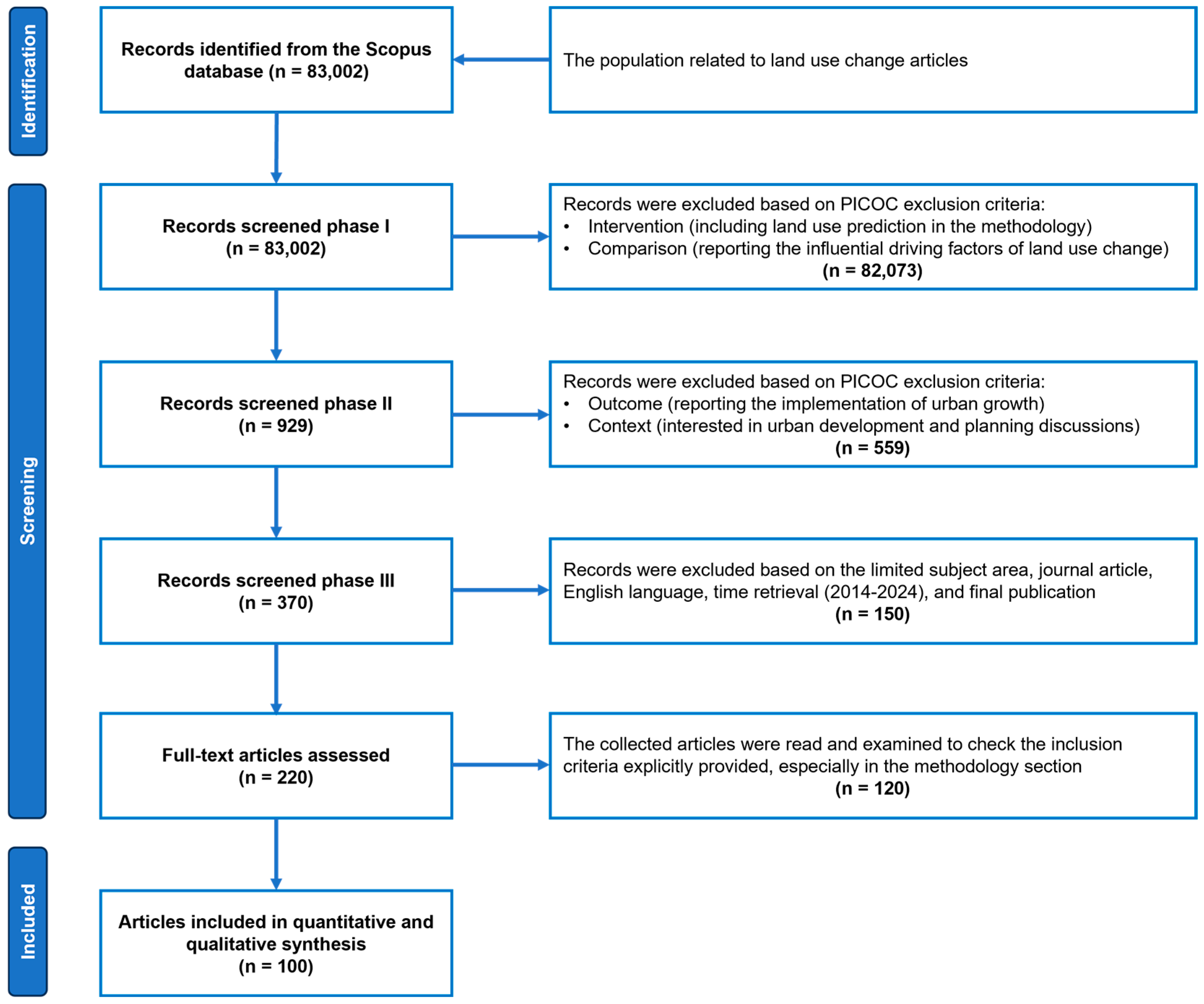




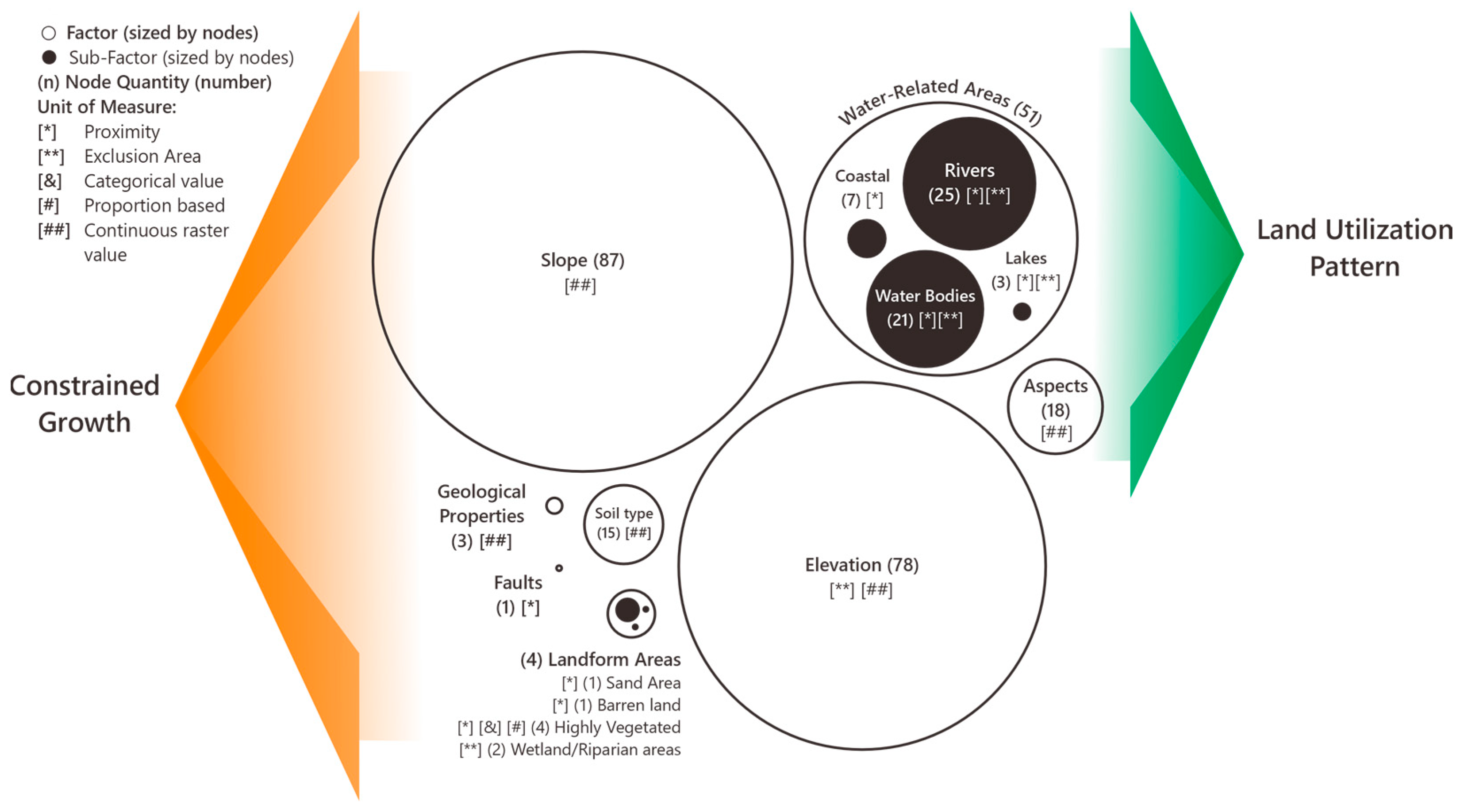

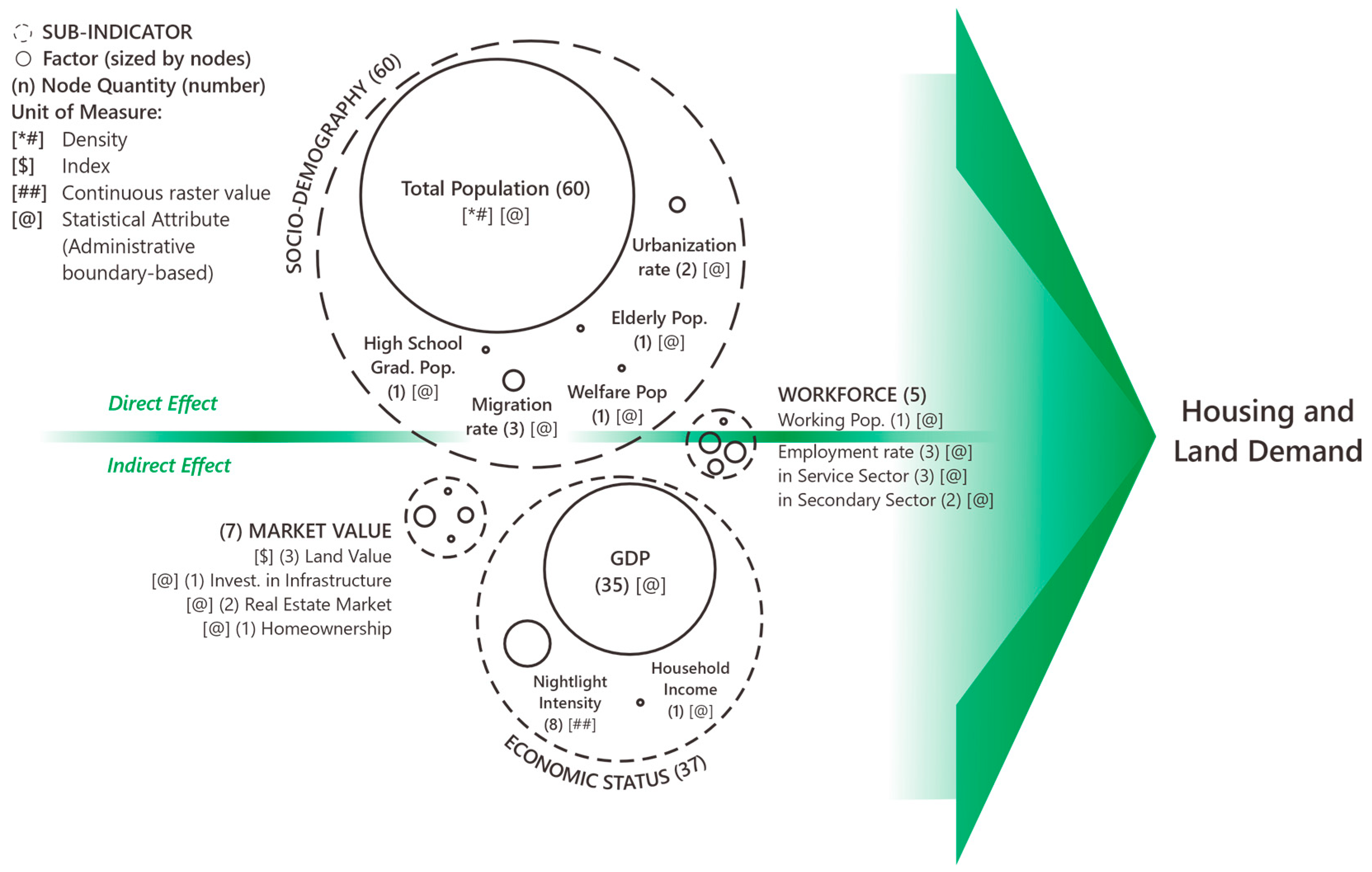

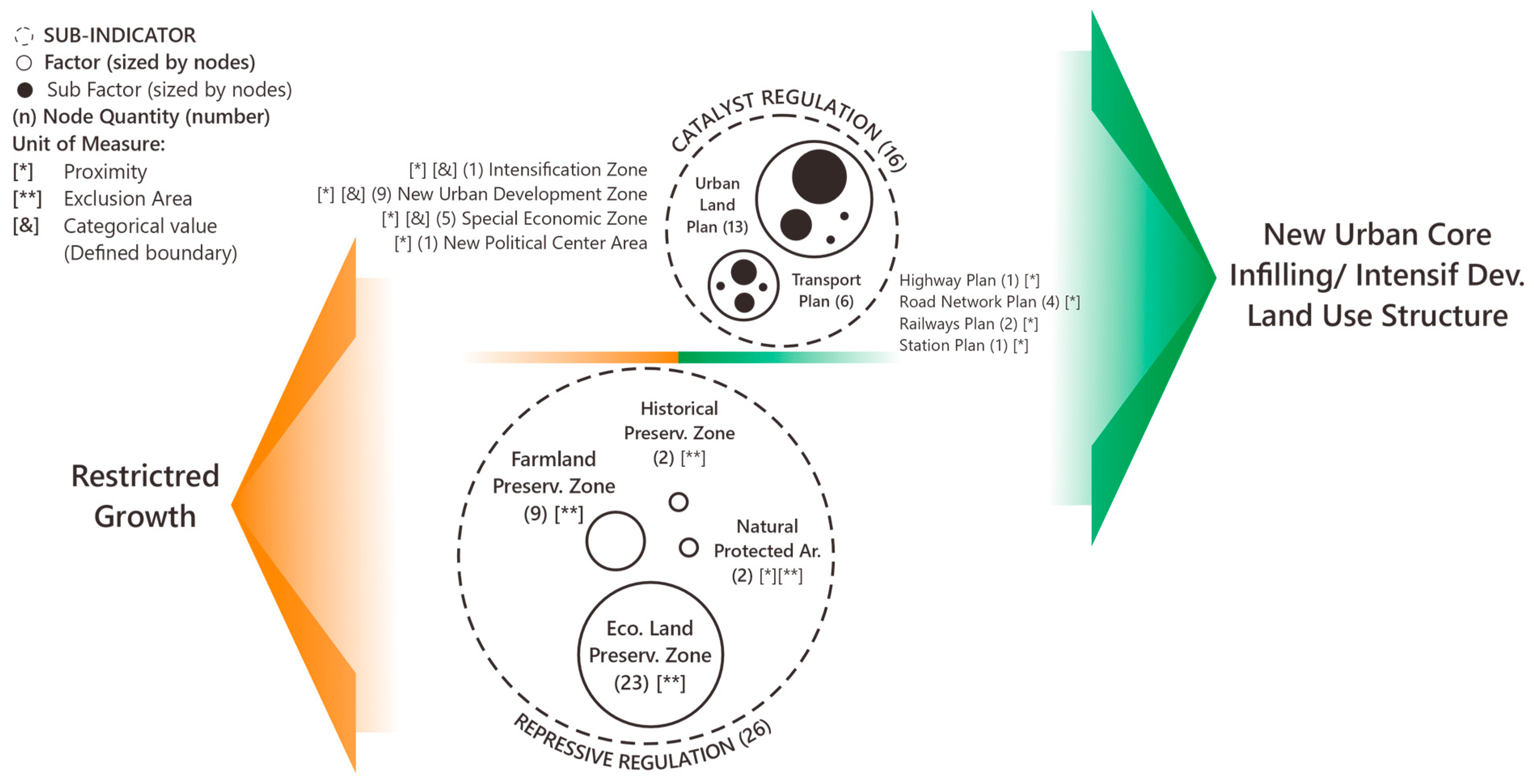

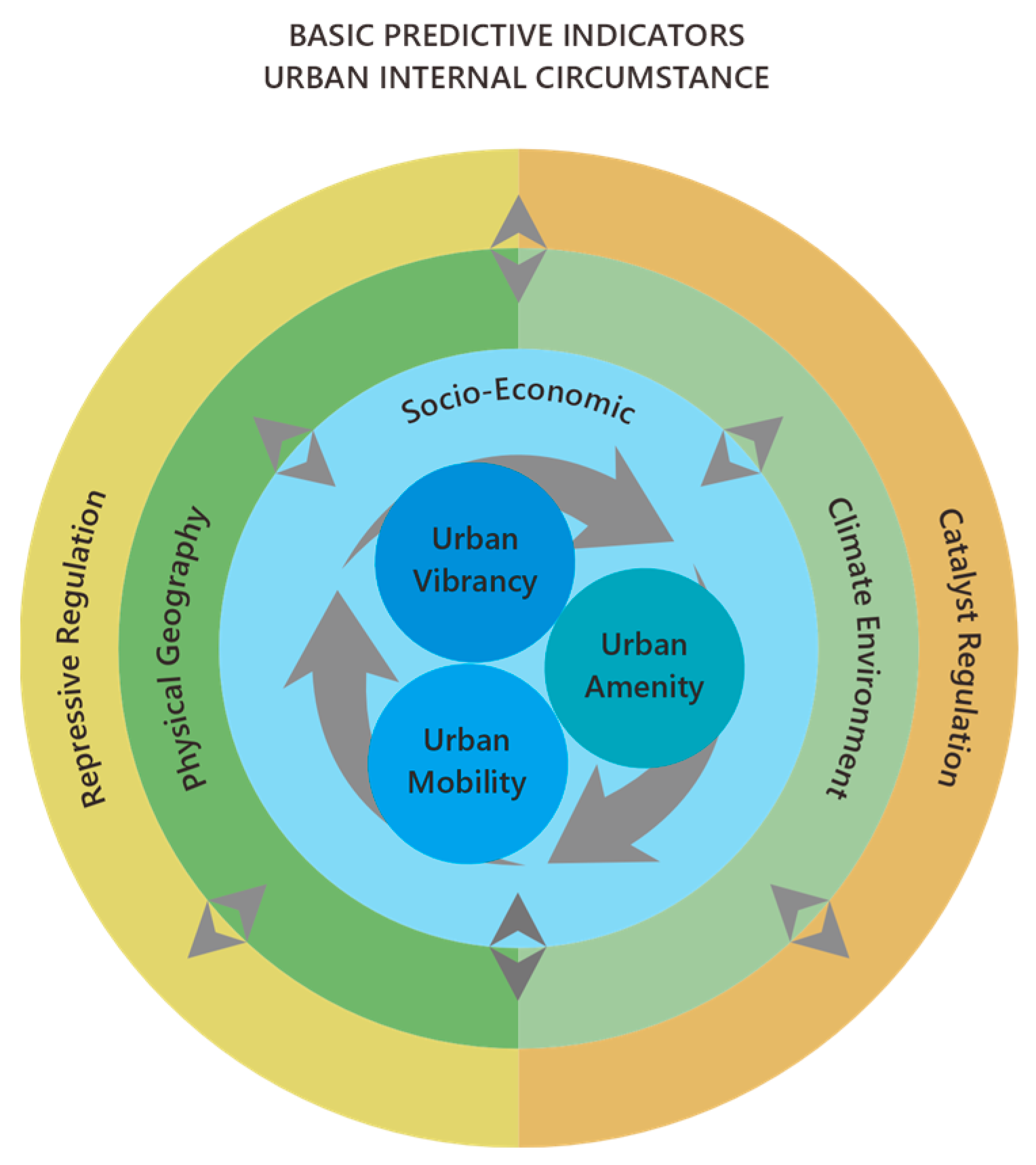
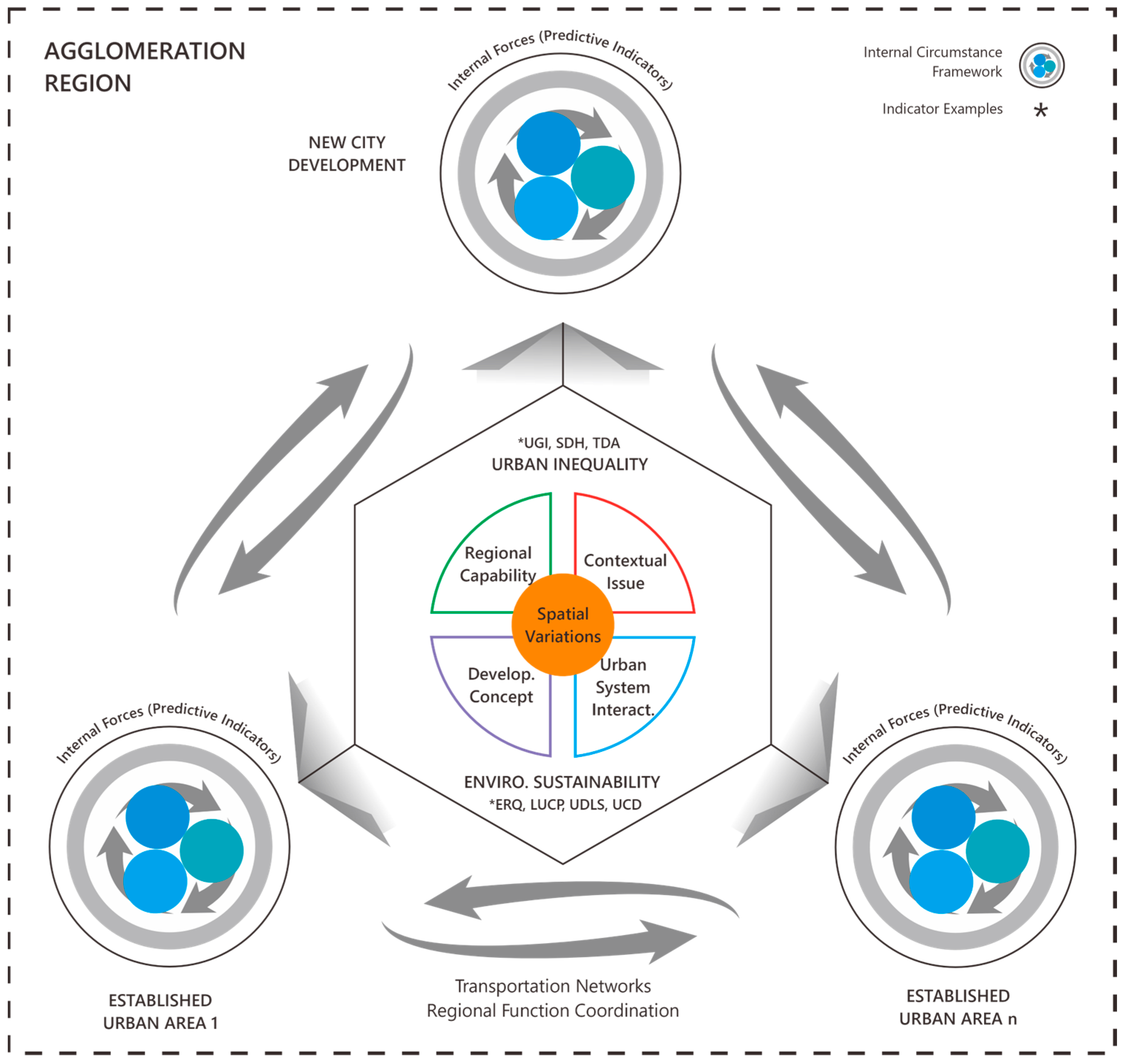
| Criteria | Inclusion Criteria | Strings and Synonyms |
|---|---|---|
| Population | Related to LUC articles | Land use: land cover, LUCC, LULC, LUC; Change: spatio-temporal, dynamic, transition, transformation |
| Intervention | The article includes land use prediction in the methodology | Prediction: future land use, modeling, projection, simulation |
| Comparison | The articles report the influential driving factors of LUC | Factor: variable, driver, contributor, indicator, parameter |
| Outcome | The article reported the implementation of urban growth | Growth: expansion, urbanization, urbanization, urban transformation |
| Context | The article was interested in urban development and planning discussions | Urban: city, regional, town; Development: planning, management |
| Integrated Indicators | Reference Mentioning | Connecting Issue |
|---|---|---|
| Ecological resistance quality (ERQ) | [19,76] | Environmental Sustainability |
| Land use conflict potential (LUCP) | [19] | |
| Urban development land use suitability (UDLS) | [19,93,97] | |
| Urban compactness (UCD) | [42] | |
| Tourism Development Assessment (TDA) | [50] | Urban Inequalities |
| Spatial development heterogeneity (SDH) | [17,59,98] | |
| Urban gravitational interaction (UGI) | [76,85,90] |
Disclaimer/Publisher’s Note: The statements, opinions and data contained in all publications are solely those of the individual author(s) and contributor(s) and not of MDPI and/or the editor(s). MDPI and/or the editor(s) disclaim responsibility for any injury to people or property resulting from any ideas, methods, instructions or products referred to in the content. |
© 2025 by the authors. Licensee MDPI, Basel, Switzerland. This article is an open access article distributed under the terms and conditions of the Creative Commons Attribution (CC BY) license (https://creativecommons.org/licenses/by/4.0/).
Share and Cite
Ghozali, A.; de Vries, W.T. Shaping Future Urbanization: A Systematic Review of Predictive and Preventive LUC Indicators for Sustainable New City Development. Urban Sci. 2025, 9, 484. https://doi.org/10.3390/urbansci9110484
Ghozali A, de Vries WT. Shaping Future Urbanization: A Systematic Review of Predictive and Preventive LUC Indicators for Sustainable New City Development. Urban Science. 2025; 9(11):484. https://doi.org/10.3390/urbansci9110484
Chicago/Turabian StyleGhozali, Achmad, and Walter Timo de Vries. 2025. "Shaping Future Urbanization: A Systematic Review of Predictive and Preventive LUC Indicators for Sustainable New City Development" Urban Science 9, no. 11: 484. https://doi.org/10.3390/urbansci9110484
APA StyleGhozali, A., & de Vries, W. T. (2025). Shaping Future Urbanization: A Systematic Review of Predictive and Preventive LUC Indicators for Sustainable New City Development. Urban Science, 9(11), 484. https://doi.org/10.3390/urbansci9110484







